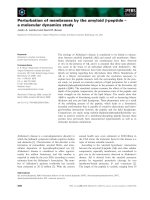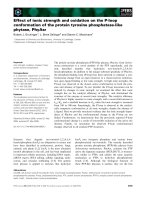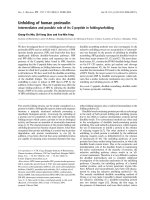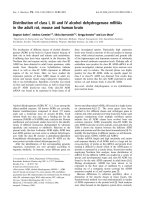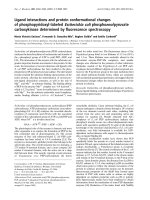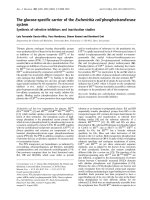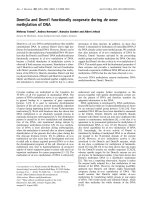Tài liệu Báo cáo Y học: Oxidation of phenols by laccase and laccase-mediator systems doc
Bạn đang xem bản rút gọn của tài liệu. Xem và tải ngay bản đầy đủ của tài liệu tại đây (293.86 KB, 6 trang )
Oxidation of phenols by laccase and laccase-mediator systems
Solubility and steric issues
Francesca d’Acunzo, Carlo Galli and Bernardo Masci
Dipartimento di Chimica and Centro CNR Meccanismi di Reazione, Universita
`
ÔLa SapienzaÕ, 00185 Roma, Italy
To investigate how solubility and steric issues affect the
laccase-catalysed oxidation of phenols, a series of oligomeric
polyphenol compounds, having increasing size and
decreasing solubility in water, was incubated with laccase.
The extent of substrate conversion, and the nature of the
products formed in buffered aqueous solutions, were com-
pared to those obtained in the presence of an organic
cosolvent, and also in the presence of two mediating species,
i.e. N-hydroxyphthalimide (HPI) and 2,2,6,6-tetramethyl-
piperidin-1-yloxy (TEMPO). This approach showed not
only an obvious role of solubility, but also a significant role
of the dimension of the substrate upon the enzymatic reac-
tivity. In fact, reactivity decreases as substrate size increases
even when solubility is enhanced by a cosolvent. This effect
may be ascribed to limited accessibility of encumbered sub-
strates to the enzyme active site, and can be compensated
through the use of the appropriate mediator. While TEMPO
was highly efficient at enhancing the reactivity of large, less
soluble substrates, HPI proved less effective. In addition,
whereas the laccase/HPI system afforded the same products
as laccase alone, the use of TEMPO provided a different
product with high specificity. These results offer the first
evidence of the role of Ôoxidation shuttlesÕ that the media-
tors of laccase may have, but also suggest two promising
routes towards an environmentally friendly process for
kraft pulp bleaching: (a) the identification of mediators
which, once oxidized by laccase, are able to target strategic
functional groups present in lignin, and (b) the introduction
of those strategic functional groups in an appropriate
pretreatment.
Keywords: laccase; phenols; lignin degradation; HPI;
TEMPO.
Lignin is a three-dimensional, insoluble aromatic polymer
that constitutes 15–33% of biomass. Its structure encom-
passes a number of different types of links between its
constituents, namely ether and C-C diaryl linkages [1].
White-rot fungi achieve the oxidative depolymerization of
lignin by secreting several enzymes, such as lignin peroxidase
[2], manganese peroxidase [3], and laccase (EC 1.10.3.2) [4].
In contrast with lignin peroxidase and manganese peroxi-
dase, laccase can only oxidize the phenolic constituents of
lignin, due to its lower oxidation potential. On the other
hand, it is more readily available and easier to manipulate
than the other two enzymes, and its substrate specificity is
low, as long as a good match of oxidation potentials is
provided [5–8]. In addition, the use of appropriate low
molecular-mass compounds (viz., mediators), in combina-
tion with laccase, makes this enzyme competent for the
oxidation of Ônon-naturalÕ nonphenolic substrates [9–12]. In
fact, the oxidized mediator (Fig. 1) can rely on an oxidation
mechanism that is not available to the enzyme [13].
Laccase can therefore be turned into a much more
versatile enzyme, and this opens up various possible
applications, as in the textile dye bleaching [14], or for
environmentally respectful kraft pulp delignification [10,15],
or also in selective organic transformations [16–19]. The
study presented here is part of our efforts to elucidate the
mechanisms of action of the laccase/mediator systems [20] in
the oxidation of lignin model compounds, as well as non-
lignin-related structures (Fig. 1).
A conceivable role of the mediator could be that of a sort
of Ôelectron shuttleÕ between the enzyme and the substrate
[21]. Once the mediator is oxidized by the enzyme, it diffuses
away from the enzymatic pocket and in turn oxidizes
substrates that, due to their size, could not directly enter the
enzymatic pocket. Within this framework, we wished to
investigate the influence of substrate size and solubility on
the effectiveness of laccase oxidation, and also the effect of
mediators endowed with possibly different mechanisms of
action. To this aim, we needed to start from a simple
phenolic structure, which laccase could recognize as a
ÔnaturalÕ substrate, and modify it into bigger and more
insoluble derivatives. The oligomeric series shown in Fig. 2
served our purposes for the following reasons: (a) each
repeat unit is a phenol, and therefore subject to oxidation
by laccase, at least in terms of redox potential; (b) the
number of repeat units in each oligomer, and therefore its
size, is exactly determined, because directed synthesis and
Fig. 1. Catalytic cycle of a laccase-mediator oxidation system.
Correspondence to C. Galli, Dipartimento di Chimica and Centro
CNR Meccanismi di Reazione, Universita
`
ÔLa SapienzaÕ,
00185 Roma, Italy. Fax: + 39 06 490421,
E-mail:
Abbreviations:HPI,N-hydroxyphthalimide; TEMPO, 2,2,6,6-
tetramethylpiperidin-1-yloxy; ABTS, 2,2¢-azinobis-(3-ethylbenzothi-
azoline-6-sulfonate).
(Received 18 June 2002, revised 9 September 2002,
accepted 12 September 2002)
Eur. J. Biochem. 269, 5330–5335 (2002) Ó FEBS 2002 doi:10.1046/j.1432-1033.2002.03256.x
suitable purification allowed pure monodisperse oligomers
to be available; (c) solubility in water decreases as size
increases; and (d) o-o-p-substitution should inhibit C-C
diaryl bond formation, a well-known reaction pathway of
phenoxy radicals [1,12].
We chose N-hydroxyphtalimide (HPI) and 2,2,6,6-
tetramethylpiperidin-1-yloxy free radical (TEMPO) as
mediators, since they greatly differ both in their mechan-
ism of action and in their specificity. In fact, HPI is
representative of a mediator that, after having been oxidized
by laccase, should only induce the generation of phenoxy
radical(s) from the substrate (Fig. 3A) [18,20,22–24]. This
radical role of the oxidized HPI would be comparable to the
ÔnaturalÕ oxidation role of the enzyme, with the only
difference of presenting fewer stringent steric and solubility
requirements. The phenoxy radical of the product, in turn,
should evolve towards end-products with little or no further
intervention from HPI.
On the other hand, TEMPO is representative of a
mediator that, by selectively interacting with specific func-
tional groups [25] (i.e. alcohols) (Fig. 3B), not only acts as a
shuttle for the oxidizing power of laccase towards insoluble
or bulky substrates, but also induces the formation of
different products than the ÔphysiologicalÕ ones. This aspect
may prove useful for synthetic purposes, as well as in lignin
degradation. The mechanism reported in Fig. 3B matches
the well-established one reported for the oxidation of
alcohols by catalytic amounts of TEMPO with stoichio-
metric co-oxidants [25–27]. In all these cases the oxoam-
monium form of TEMPO is involved. In our particular
case, laccase would be the catalytic oxidant of TEMPO [17].
Following a nucleophilic attack of the lone-pair of the
alcohol onto the TEMPO-oxoammonium ion, the interme-
diate adduct is deprotonated at the a-C-H benzylic bond by
the base-form of the buffer B [17,25–27].
In order to decouple the effect of increasing substrate-size
and decreasing solubility, the oxidations were carried out in
1 : 1 aqueous buffer/dioxane, and the results compared with
those obtained in 100% aqueous buffer.
MATERIALS AND METHODS
Laccase
Laccase from Poliporus pinsitus was kindly donated by
Novo Nordisk Biotech and purified by ion-exchange
chromatography on Q-Sepharose by elution with phosphate
buffer [5,20], and an activity of 10 000 UÆmL
)1
determined
spectrophotometrically by the standard reaction with ABTS
[28]. Laccase having an absorption ratio A
280
/A
610
of 20–30
was considered sufficiently pure [5].
Materials
HPI and TEMPO were used as received from Aldrich. The
solvents were from Aldrich, Merck or Carlo Erba.
Synthesis of substrates
Compounds 2–4 were prepared according to a literature
procedure [29]. The latter procedure was also extended to
the stepwise synthesis of compound 5, the pentaphenol
condensation product obtained from compound 3 and
4-tert-butylphenol being bis-hydroxymethylated. The purity
of these compounds (> 96%) was checked by
1
HNMR
and HPLC.
Spectrophotometric determination of laccase activity
The activity of laccase was determined by following the rate
of oxidation of 2,2¢-azinobis-(3-ethylbenzothiazoline-6-
sulfonate) (ABTS) to ABTS radical cation (ABTS
•+
), by
plotting the absorbance at 414 nm against time [28].
The extinction coefficient of ABTS
•+
at 414 nm is
3.15 · 10
)4
M
)1
Æcm
)1
. ABTS (Aldrich) was recrystallized
Fig. 3. Mechanisms of the O
2
-laccase-HPI (A) and O
2-
laccase-
TEMPO (B) oxidation of substrates 1–5 (Fig. 2).
Fig. 2. Oligomeric compounds 1–5.
Ó FEBS 2002 Oxidation of phenols (Eur. J. Biochem. 269) 5331
from ethanol prior to use. A stock solution was prepared by
dissolving 3 mg of ABTS in 10 mL 0.1
M
citrate buffer at
pH 5.0; 200 lL of the stock solution were added to 3 mL
citrate buffer in a quartz cuvette (10 mm pathlength); 1 lL
of laccase solution, approximately 10–20 UÆmL
)1
,was
then added, and the initial rate of ABTS
•+
formation
was determined. The 10–20 UÆmL
)1
laccase activity was
achieved by diluting the purified laccase solution in citrate
buffer.
Evaluation of substrates solubility
The solubility of substrates 2, 3, 5 was evaluated by UV-Vis
spectrometry. A Hewlett Packard 8453 diode-array single
beam spectrophotometer was used. A 2.0-m
M
stock solution
of each substrate was prepared in dioxane; aliquots (5.0 lL)
of the stock solution were added to 2.5 mL of 1 : 1 (v/v) 0.1
M
citrate buffer pH 5.0/dioxane mixed solvent in a 10-mm
quartz cuvette. Spectra were recorded in the 220–320 nm
range, and the absorbance at 280 nm was plotted against
concentration.
Oxidations catalysed by laccase and laccase/mediator
systems
In a typical experiment, 60 lmol of substrates 1–5 were
weighedina2-mLscrew-capvialequippedwithastirring
bar. In the experiments with mediators, 20 lmol HPI or
TEMPO were also added. In the experiments with aqueous
solvent only, 0.3 mL of 0.1
M
citrate buffer, pH 5.0, were
added at this point, followed by 9–10 U of purified laccase.
In the experiments with the mixed solvent, 0.15 mL of
dioxane were added first, followed by an equal amount of
citrate buffer and 9–10 U laccase. The reaction mixture was
allowed to react at room temperature for 24 h. The vials
were left uncapped and vigorous stirring was maintained in
order to ensure oxygen saturation.
HPLC determination of substrate conversion
Substrate consumption after a 24-h reaction time was
determined using a Hewlett-Packard 1050 HPLC system
(pump, detector, and solvent delivery system) equipped with
a Supelcosil LC-18-DB 25 cm · 4.6 mm column and a HP
3395B integrator. The analyses were carried out with
gradients of water/methanol/isopropanol mixtures, contain-
ing 0.03% trifluoroacetic acid, at 0.5–1 mLÆmin
)1
flow rate.
Quantitation of unreacted substrate was achieved by using
2-bromonaphtalene (Aldrich) as the internal standard. The
standard was added to the reaction crude, which was then
diluted in the mobile phase and filtered through 0.2 lm
Teflon syringe filters (Superchrom Varisep) prior to
analysis.
Product analysis: liquid mass spectrometry (LC-MS)
The analysis was carried out using a triple quadrupole
Perkin Elmer Sciex API 365 spectrometer with a turbo–ion
spray interface. Samples were diluted in HPLC-grade
methanol and filtered through 0.2 lm Teflon syringe filters
prior to injecting. The samples were directly injected into the
ion spray chamber without chromatographic separation.
Product analysis:
1
H-NMR
Samples were dissolved in dimethylsulfoxide-d
6
(Merck)
and spectra were acquired using a Varian 300 MHz
spectrometer with a Mercury console.
RESULTS AND DISCUSSION
Solubility of substrates
This was assessed by a UV-Vis spectrophotometric experi-
ment, aimed at verifying that the substrates were soluble in
the buffer/dioxane mixed solvent up to the concentration
used in the laccase-catalysed reaction. We checked that the
absorbance at 280 nm, corresponding to the maximum
absorbance of the substrates, increases linearly with sub-
strate concentration without scatter from precipitation.
Furthermore, we checked that the absorbance falls to zero
outside the peak, i.e. that no wavelength-independent
turbidity arises from precipitation. We thus verified that
solutions of substrates 2–5 as concentrated as 85 l
M
can be
prepared. However, the solution containing substrate 5
became visibly turbid after 24 h. We therefore concluded
that the heaviest of our substrates can yield over-saturated
solutions in the buffer/dioxane mixed solvent, at the
concentrations used for the oxidation reaction.
Substrate consumption
Table 1 summarizes the results of our laccase oxidations of
substrates 1–5, and the effect of the cosolvent and of the
mediators on the amount of substrate metabolized by the
enzyme.
(a) Laccase and laccase/HPI. In general, the use of the
buffer/dioxane mixed solvent enhances substrate conversion
both with and without mediator. The monomeric substrate
Table 1. Percent of substrate metabolized by laccase or laccase/mediator systems with and without an organic cosolvent. Substrate recovery was
determined by HPLC.
No mediator HPI TEMPO
Substrate Buffer Buffer/dioxane Buffer Buffer/dioxane Buffer Buffer/dioxane
1 100 100 – – – –
2 33 96 – 100 – 96
3 18 55 20 60 32 95
4 00 0 0 687
5 00 0 0 040
5332 F. d’Acunzo et al.(Eur. J. Biochem. 269) Ó FEBS 2002
1, which is the smallest and the most soluble, is metabolized
quantitatively in buffered water. This is reasonable, in view
of its phenolic nature. With phenols 2 and 3, however, the
extent of substrate oxidation is much lower; the use of the
cosolvent makes the consumption of 2 quantitative, whereas
that of 3 remains around 55%, and no conversion is
observed for substrates 4 and 5. Moving to the experiments
with mediators, we observe that HPI does not provide any
significant improvement in the extent of substrate oxidation
with respect to laccase alone, nor promote the oxidation of
the bulkiest substrates (4 and 5). On the other hand,
literature evidence supporting the ability of HPI to act as a
mediator in laccase-catalysed oxidations of different sub-
strates is available [18,22,23].
(b) Laccase/TEMPO. The effect of TEMPO is much
more remarkable than that of HPI (Table 1). In fact, when
TEMPO is used in the mixed solvent, substrate 3 is
quantitatively consumed, and substrates 4 and 5 are also
significantly oxidized. A small amount of 4 is oxidized by
the laccase/TEMPO system even in the simple buffered
solution, namely, in the absence of cosolvent. This proves
that the appropriate choice of a mediator is of utmost
importance with substrates of limited solubility. In partic-
ular, the formation of the TEMPO-substrate adduct
(Fig. 3B) may account for the enhanced reactivity of poorly
soluble substrates. Conversely, HPI, which does not form
adducts, can only react with the amount of substrate
dissolved in solution, thus showing no advantage over
laccase alone.
Product identification
(a) Laccase and laccase/HPI.
1
H-NMR (Fig. 4) and
LC-MS (Table 2) spectra indicate that with substrates 1 and
2 the same products are formed both in the absence and in
the presence of HPI.
The general reaction schemes that rationalize the prod-
ucts observed are sketched in Fig. 5. Figure 5A shows a
dimerization process with loss of formaldehyde, while the
ring-opening products indicated in Fig. 5B derive from the
attack of dioxygen on the phenoxy radical [12]. The spectra
in Fig. 4 refer to oxidations carried out in the mixed
Fig. 4. Expansion of
1
H-NMR spectra run in dimethylsulfoxide-d
6
of
the product mixtures from the laccase-catalysed oxidation of substrates 1
and 2. Peaks in the aromatic region (6.6–7.8 p.p.m.) are assigned to
arylether products (Fig. 5A). Peaks in the 6.0–6.6 p.p.m. region are
attributed to vinylic protons of unsaturated carboxylic acids (Fig. 5B).
A signal from a mobile proton is also present at 11.5 p.p.m., which is
assigned to the carboxylic moieties.
Table 2. LC-MS data for the main product detected in the reaction
mixture from the laccase-catalysed oxidation of substrates 1 and 2.
a
M stands for molecular ion; A, B and C are the fragments rep-
resented in the Product column.
Fig. 5. Oxidation of substrates 1–5 by O
2
-laccase and O
2
-laccase-HPI.
Phenol coupling with loss of formaldehyde (A) and ring-opening (B).
Ó FEBS 2002 Oxidation of phenols (Eur. J. Biochem. 269) 5333
solvent, namely, in conditions in which substrate con-
sumption is nearly quantitative and dimerization products
are likely to undergo further reaction, both of type (A) and
(B) (in Fig. 5). Complex reaction mixtures are expected
and the spectra can be further complicated by the presence
of slowly interconverting conformers, so that we do not
attempt to assign the observed peaks to specific structures.
In the product mixtures from both substrates 1 and 2,
peaks are found in the aromatic (6.6–7.8 p.p.m.) and in the
vinylic (6–6.6 p.p.m.) regions. A signal from an acidic
proton at 11.5 p.p.m. (not shown), which is suppressed by
the addition of D
2
O, is also detected. The peaks in the
aromatic region are attributed to products from the
dimerization (and the like) reaction shown in Fig. 5A,
while the vinylic signals and the peak at 11.5 p.p.m. are
assigned to the unsaturated carboxylic acids resulting from
the ring-opening reactions, as reported in Fig. 5B. No
specific ring-opening product from substrate 2 could be
detected by LC-MS, even though the formation of small
amounts of olefinic products is indicated by
1
H-NMR
spectra also in this case (Fig. 4). There is no evidence of
oxidation of the internal methylenes. In conclusion, the
1
H-
NMR spectra are compatible with product formation
according to the reactions sketched in Fig. 5, which we
expected on the basis of literature data [12], and for which
LC-MS (Table 2) provides evidence.
(b) Laccase/TEMPO. TEMPO is known to selectively
oxidize alcohols to aldehydes [17,25–27]. Consistent with
this evidence, and in contrast with the outcome of the
laccase and laccase/HPI reactions, the only product
observed (by
1
H-NMR), when substrate 4 is reacted with
the laccase/TEMPO system in the mixed solvent, results
from the oxidation of the hydroxymethyl groups to
aldehydes. It is worth mentioning that substrate 4 does
not react with laccase alone in the mixed solvent, whereas
TEMPO does not react with the substrate in the absence of
laccase. Therefore, this is a simple setting in which the
products observed can unambiguously be ascribed to the
mediating action of TEMPO on the enzyme. On the other
hand, when the monomeric substrate 1 is reacted with the
laccase/TEMPO system,
1
H-NMR product analysis shows
a more complex situation. Specifically, no phenolic coupling
products are observed, the aldehydic signals are prominent,
and several signals are present in the aromatic region. It is
quite likely that TEMPO not only acts as a mediator (which
accounts for aldehyde formation) but, in view of its known
role as an inhibitor of free-radical chains, it also traps the
phenoxy radicals formed by the direct interaction of
substrate 1 with laccase [26,30].
CONCLUSIONS
The oxidation of an oligomeric series of phenols with
laccase alone, or in combination with two mediators (HPI
and TEMPO) was investigated in buffered water solution or
in a 1 : 1 buffer/dioxane mixed solvent. HPI, a mediator
that promotes the formation of the same phenoxy radical
intermediate as laccase, yields the same products as the
enzyme alone, namely, ring-opening and phenol coupling
products, with a comparable extent of substrate consump-
tion. On the other hand, the laccase/TEMPO system
performs the selective oxidation of the hydroxymethyl
groups of the substrate to aldehydes. Both with laccase
alone and with the laccase/HPI system, a limited enhance-
ment of the extent of oxidation was obtained by the use of
the cosolvent with the smaller substrates 1–3, but no
oxidation was obtained with the bulkiest substrates 4 and 5.
We therefore conclude that no benefit derives from the use
ofamediatorsuchasHPI,whichformsthesame
intermediate as the enzyme, whenever size and solubility
issues need be addressed. On the other hand, the laccase/
TEMPO system not only affords the oxidation of the
bulkiest and least soluble substrates, but it also benefits from
the enhancement of substrate solubility achieved with the
cosolvent. Aldehydes are exclusively obtained with those
substrates that are only oxidized in the presence of TEMPO
(4 and 5), while a more complex product mixture results
with substrate 1, which can be oxidized not only by TEMPO
but also by laccase directly. We conclude that the laccase/
TEMPO system, possibly in a mixed solvent, may prove
useful for the oxidation of alcohols of limited solubility, that
are not directly oxidized by laccase. These results therefore
provide the first experimental support to the idea that a
mediator of laccase activity may act as an oxidation shuttle
capable to overcome solubility and/or restricted-access
problems of the substrate. In general, a possible strategy
to extend the use of laccase to the oxidation of substrates
that cannot react with the enzyme alone is to select
mediators that can specifically interact with target func-
tional groups, through reaction pathways that are different
from those directly accessible to laccase. A foreseeable
strategy for any laccase-catalysed wood pulp bleaching is to
investigate mediators that can specifically interact with
functional groups present on lignin. Alternatively, specific
functional groups that are susceptible to oxidation from this
particular mediator might be introduced on lignin in a
preoxidation stage.
ACKNOWLEDGEMENTS
We thank the EU for financial support (grant QLK5-CT-1999–01277)
to the OXYDELIGN project.
REFERENCES
1. Schoemaker, H.E. (1990) On the chemistry of lignin biodegrada-
tion. Trav. Chim. Pays-Bas 109, 255–272.
2. Tien, M. & Kirk, T.K. (1983) Lignin-degrading enzyme from the
hymenomycete Phanerochaete chrysosporium burds. Science 221,
661–663.
3. Kuwahara,M.,Glenn,J.K.,Morgan,A.&Gold,M.H.(1984)
Separation and characterization of two extracellular H
2
O
2
-
dependent oxidases from ligninolytic cultures of Phanerochaete
chrysosporium. FEBS Lett. 169, 247–250.
4. Messerschmidt, A. (1997) Multi-Copper Oxidases, World Scienti-
fic, Singapore.
5. Xu, F. (1996) Oxidation of phenols, anilines, and benzenethiols by
fungal laccases: correlation between activity and redox potentials
as well as halide inhibition. Biochemistry 35, 7608–7614.
6. Itoh, K., Fujita, M., Kumano, K., Suyama, K. & Yamamoto, H.
(2000) Phenolic acids affect transformations of chlorophenols by a
Coriolus Versicolor laccase. Soil Biol. Biochem. 32, 85–91.
7. Guille
´
n, F., Mun
˜
oz, C., Go
´
mez-Toribio, V., Martı
´
nez, A.T. &
Martı
´
nez, M.J. (2000) Oxygen activation during oxidation of
methoxyhydroquinones by Laccase from Pleurotus eryngii. Appl.
Environ. Microb. 66, 170–175.
5334 F. d’Acunzo et al.(Eur. J. Biochem. 269) Ó FEBS 2002
8. Kersten, P.J., Kalyanaraman, B., Hammel, K.E., Reinhammar, B.
& Kirk, T.K. (1990) Comparison of lignin peroxidase, horseradish
peroxidase and laccase in the oxidation of methoxybenzenes.
Biochem. J. 268, 475–480.
9. Bourbonnais, R. & Paice, M.G. (1990) Oxidation of non-phenolic
substrates. An expanded role for laccase in lignin biodegradation.
FEBS Lett. 267, 99–102.
10. Bourbonnais, R. & Paice, M.G. (1992) Demethylation and
delignification of kraft pulp by Trametes versicolor laccase in the
presence of ABTS. Appl. Microbiol. Biot. 36, 823–827.
11. Bourbonnais, R., Paice, M.G., Freiermuth, B., Bodie, E. &
Borneman, S. (1997) Reactivities of various mediators and
laccases with kraft pulp and lignin model compounds. Appl.
Environ. Microb. 63, 4627–4632.
12. Crestini, C. & Argyropoulos, D.S. (1998) The early oxidative
biodegradation steps of residual kraft lignin models with laccase.
Bioorgan. Med. Chem. 6, 2161–2169.
13. Hilde
´
n,L.,Johansson,G.,Pettersson,G.,Li,J.,Ljungquist,P.&
Henriksson, G. (2000) Do the extracellular enzymes cellobiose
dehydrogenase and manganese peroxidase form a pathway in
lignin biodegradation? FEBS Lett. 477, 79–83.
14. Deussen, H J. & Johansen, C. (2000) Enzymatic
antimicrobial composition, useful in, e.g. laundries, cosmetic
products, and contact lenses, comprises a phenol oxidising enzyme
system and an N-hydroxyanilide enhancing agent. PCT Interna-
tional Patent WO 0027204, A1. European Patent Office, Munich,
Germany.
15. Call, H P. & Mu
¨
cke, I. (1997) History, overview and applications
of mediated lignolytic systems, especially laccase-mediator-sys-
tems (Lignozym-process). J. Biotechnol. 53, 163–202.
16. Potthast, A., Rosenau, T., Chen, C.L. & Gratzl, J.S. (1995)
Selective enzymatic oxidation of aromatic methyl groups to
aldehydes. J. Org. Chem. 60, 4320–4321.
17. Fabbrini, M., Galli, C., Gentili, P. & Macchitella, D. (2001)
An oxidation of alcohols by oxygen with the enzyme
laccase, and mediation by TEMPO. Tetrahedron Lett. 42, 7551–
7553.
18. Fritz-Langhals, E. & Kunath, B. (1998) Synthesis of aromatic
aldehydes by laccase-mediator assisted oxidation. Tetrahedron
Lett. 39, 5955–5956.
19. Johannes, C. & Majcherczyk, A. (2000) Natural mediators in the
oxidation of polycyclic aromatic hydrocarbons by laccase med-
iator systems. Appl. Environ. Microb. 66, 524–528.
20. Fabbrini, M., Galli, C. & Gentili, P. (2002) Comparing the effi-
ciency of some mediators of laccase. J. Mol. Catal. B: Enzym. 16,
231–240.
21. Banci, L., Ciofi-Baffoni, S. & Tien, M. (1999) Lignin and Mn
peroxidase-catalysed oxidation of phenolic lignin oligomers. Bio-
chemistry 38, 3205–3210.
22. Xu,F.,Kulys,J.J.,Duke,K.,Li,K.,Krikstopaitis,K.,Deussen,
H J.W., Abbate, E., Galinyte, V. & Schneider, P. (2000) Redox
chemistry in laccase-catalysed oxidation of N-hydroxy com-
pounds. Appl. Environ. Microb. 66, 2052–2056.
23. Sealey, J., Ragauskas, A.J. & Elder, T.J. (1999) Investigations into
laccase-mediator delignification of kraft pulps. Holzforschung 53,
498–502.
24. Ueda, C., Noyama, M., Ohmori, H. & Masui, M. (1987)
Reactivity of phthalimide-N-oxyl: a kinetic study. Chem. Pharm.
Bull. 35, 1372–1377.
25. de Nooy, A.E.J., Besemer, A.C. & van Bekkum, H. (1996) On the
use of stable organic nitroxyl radicals for the oxidation of primary
and secondary alcohols. Synthesis 1153–1174.
26. Cecchetto, A., Fontana, F., Minisci, F. & Recupero, F. (2001)
Efficient Mn-Cu and Mn-Co-TEMPO catalysed oxidation of
alcohols into aldehydes and ketones by oxygen under mild con-
ditions. Tetrahedron Lett. 42, 6651–6654.
27. De Mico, A., Margarita, R., Parlanti, L., Vescovi, A. & Pianca-
telli, G. (1997) A versatile and highly selective hypervalent iodine
(III)/TEMPO-mediated oxidation of alcohols to carbonyl com-
pounds. J. Org. Chem. 62, 6974–6977.
28. Wolfenden, B.S. & Willson, R.L. (1982) Radical cations as
reference chromogens in kinetic studies of one-electron transfer
reactions: pulse radiolysis studies of ABTS. J. Chem. Soc., Perkin
Trans. 2, 805–812.
29. Dahwan, B. & Gutsche, C.D. (1983) Calixarenes. 10. Oxacalix-
arenes. J. Org. Chem. 48, 1536–1539.
30. Minisci, F., Punta, C., Recupero, F., Fontana, F. & Pedulli, G.F.
(2002) Aerobic oxidation of N-alkylamides catalysed by
N-hydroxyphthalimide under mild conditions. J. Org. Chem.
67, 2671–2676.
Ó FEBS 2002 Oxidation of phenols (Eur. J. Biochem. 269) 5335

